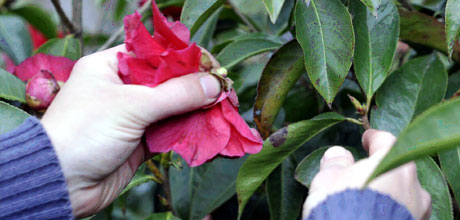Dead-head Your Camellias
This article was first published on 29 Sep 2011.

Camellias
What?
Dead-heading is one of the most important and satisfying tasks to do for your camellias. Dead-heading uses just your bare hands and perhaps a ladder for a taller bush. Take the finished flower and give it a twist, carefully holding the stem where it is attached to the base, if needed. It should come off without damaging the developing growth tip just below the flower, or any other flower buds.
Why?
Camellias look most spectacular in flower when they have the old and damaged blooms removed. Removing old flowers also provides space for nearby flower buds to open.
Camellia petal blight, Ciborinia camelliae, is a fungal disease which is specific to camellias and affects the flowers. The most effective way to combat this disease is to remove the blooms from the area.
This disease is relatively new to New Zealand and has become well established over several years. The air-borne spores are prevalent during the camellia flowering season and when they land on a flower they cause a brown spot which quickly spreads into the centre of the flower. When the flower drops to the ground the life cycle continues by producing a tiny mushroom during the flowering season, which releases the spores.
When?
Dead-head as often as you can during the flowering season.
Where?
There are just over 700 camellias being dead-headed in the camellia collection in the lower Dunedin Botanic Garden. Unfortunately there’s only one of me! If you are willing to help with deadheading, I would love to hear from you on 477-4000.
Marianne Groothuis is curator of the Camellia Collection at Dunedin Botanic Garden.


